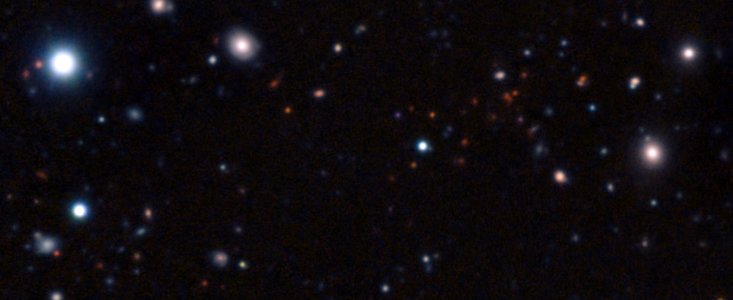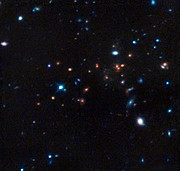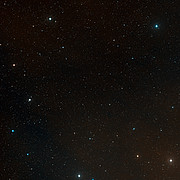Comunicato Stampa
Il più lontano ammasso di galassie “adulto”
Giovane, ma soprendentemente cresciuto
09 Marzo 2011
Gli astronomi hanno usato un esercito di telescopi a terra e nello spazio, tra cui il VLT (Very Large Telescope) dell’ESO all’Osservatorio del Paranal in Cile, per scoprire e misurare la distanza del più lontano ammasso di galassie “adulto” mai scoperto. Anche se vediamo questo ammasso in un momento in cui l’Universo aveva meno di un quarto della sua età attuale, esso è soprendentemente simile agli ammassi di galassie dell’Universo attuale.
“Abbiamo misurato la distanza del più lontano ammasso di galassie adulto mai trovato” dice l’autore principale dello studio in cui sono state usate le osservazioni del VLT dell’ESO, Raphael Gobat (CEA, Parigi). “La cosa soprendente è che quando guardiamo con attenzione questo ammasso esso non sembra particolarmente giovane – molte delle galassie sono già rilassate e non assomigliano alle galassie in piena attività di formazione stellare che si trovano di solito nell’Universo giovane”.
Gli Ammassi di galassie sono le più grandi strutture dell’Universo tenute insieme dalla forza di gravità. Gli astronomi pensano che queste strutture crescano nel tempo e che perciò gli ammassi massicci siano rari nelle prime fasi di vita dell’Universo. Anche se vengono scoperti sempre nuovi ammassi di galassie lontani, questi appaiono giovani, e nel pieno del processo di formazione. Non sono sistemi maturi già formati e rilassati.
Il gruppo internazionale di astronomi ha usato i potenti strumenti VIMOS e FORS2 installati sul telescopio VLT (Very Large Telescope) dell’ESO per misurare la distanza di alcune delle zone più dense in una singolare chiazza di oggetti rossi molto deboli già osservati con il telescopio spaziale Spitzer. Questo raggruppamento di oggetti, detto CL J 1449+0856 [1], presentava tutti i segni distintivi di un ammasso di galassie molto remoto [2]. Il risultato dell’osservazione ha dimostrato che stiamo effettivamente osservando un ammasso di galassie com’era quando l’Universo aveva circa tre miliardi di anni – meno di un quarto dell’età attuale [3].
Dopo aver misurato la distanza di questo oggetto raro, gli astronomi hanno osservato nel dettaglio le galassie che lo compongono usando sia il telescopio spaziale Hubble (NASA/ESA) che telescopi a terra, tra cui il VLT. Le prove trovate suggeriscono che molte delle galassie di questo ammasso non stanno formando stelle, ma sono invece composte di stelle vecchie di almeno un miliardo di anni. Questa misura rende l’ammasso un oggetto maturo, “adulto”, di massa simile all’ammasso della Vergine, l’ammasso ricco più vicino alla Via Lattea.
Ulteriori evidenze che questo sia un ammasso adulto vengono dall’osservazione di raggi X provenienti da CL J1449+0856 effettuate con l’osservatorio spaziale XMM-Newton dell’ESA. L’ammasso emette raggi X grazie a una nube caldissima di gas rarefatto che riempe lo spazio tra una galassia e l’altra e si concentra verso il centro dell’ammasso. Questa è un’altra indicazione che l’ammasso sia maturo, tenuto insieme dalla propria gravità, poiché un ammasso molto giovane non ha avuto tempo di catturare gas caldo in questo modo.
Come conclude Gobat: “Questi nuovi risultati coroborano l’idea che alemno alcuni ammassi “adulti” esistessero quando l’Universo aveva meno di un quarto dell’età attuale. Questi ammassi dovrebbero essere molto rari, secondo le teorie correnti, e noi siamo stati molto fortunati ad averne visto uno!. Se invece successive osservazioni ne trovassero molti di più, questo potrebbe significare che la nostra comprensione dell’Universo primordiale deve essere modificata.”
Note
[1] Questo buffo nome si riferisce alla posizione dell’oggetto in cielo.
[2] Le galassie appaiono rosse nell’immagine in parte perché si pensa che siano composte da stelle rosse e fredde. Inoltre l’espansione dell’Universo a partire dal momento in cui la luce ha lasciato questi lontani sistemi ha fatto aumentare ulteriormente la lunghezza d’onda della radiazione così che questa viene osservata come radiazione infrarossa quando raggiunge la Terra.
[3] Gli astronomi hanno misurato la distanza dell’ammasso dividendo la luce nei suoi colori componenti attraverso uno spettrografo. Hanno poi confrontato lo spettro risultante con quello di un oggetto simile nell’Universo vicino. Questo ha permesso di misurare il redshift (spostamento verso il rosso) delle galassie lontane – una misura di quanto l’Universo si è ingrandito dal momento in cui la luce ha lasciato le galassie. Il redshift è di 2.07, che significa che vediamo l’ammasso circa tre miliardi di anni dopo il Big Bang.
Ulteriori Informazioni
Questa ricerca è stata presentata in un articolo, “A mature cluster with X-ray emission at z = 2.07”, di R. Gobat et al., pubblicato nella rivista Astronomy & Astrophysics.
Il gruppo di lavoro è composto da R. Gobat (Laboratoire AIM-Paris-Saclay, Francia), E. Daddi (AIM-Parigi), M. Onodera (ETH Zurigo, Svizzera, A. Finoguenov (Max-Planck-Institut für extraterrestrische Physik, Garching, Germania), A. Renzini (INAF–Osservatorio Astronomico di Padova), N. Arimoto (National Astronomical Observatory of Japan), R. Bouwens (Lick Observatory, Santa Cruz, USA), M. Brusa (ETH), R.-R. Chary (California Institute of Technology, USA), A. Cimatti (Università di Bologna, Italia), M. Dickinson (NOAO, Tucson, USA), X. Kong (University of Science and Technology of China), and M.Mignoli (INAF – Osservatorio Astronomico di Bologna, Italia).
L’ESO (European Southern Observatory) è la principale organizzazione intergovernativa di Astronomia in Europa e l’osservatorio astronomico più produttivo al mondo. È sostenuto da 15 paesi: Austria, Belgio, Brasile, Danimarca, Finlandia, Francia, Germania, Gran Bretagna, Italia, Olanda, Portogallo, Repubblica Ceca, Spagna, Svezia, e Svizzera. L’ESO svolge un ambizioso programma che si concentra sulla progettazione, costruzione e gestione di potenti strumenti astronomici da terra che consentano agli astronomi di realizzare importanti scoperte scientifiche. L’ESO ha anche un ruolo di punta nel promuovere e organizzare la cooperazione nella ricerca astronomica. L’ESO gestisce tre siti osservativi unici al mondo in Cile: La Silla, Paranal e Chajnantor. Sul Paranal, l’ESO gestisce il Very Large Telescope, osservatorio astronomico d’avanguardia nella banda visibile. L’ESO è il partner europeo di un telescopio astronomico di concetto rivoluzionario, ALMA, il più grande progetto astronomico esistente. L’ESO al momento sta progettando l’European Extremely Large Telescope o E-ELT (significa Telescopio Europeo Estremamente Grande), di 42 metri, che opera nell'ottico e infrarosso vicino e che diventerà “il più grande occhio del mondo rivolto al cielo”.
Links
Contatti
Dr Raphael Gobat
Laboratoire AIM-Paris-Saclay, CEA/DSM-CNRS–Université Paris Diderot
Gif-sur-Yvette, France
Tel.: +33 1 69 08 60 01
E-mail: raphael.gobat@cea.fr
Richard Hook
ESO, La Silla, Paranal, E-ELT and Survey Telescopes Public Information Officer
Garching bei München, Germany
Tel.: +49 89 3200 6655
E-mail: rhook@eso.org
Anna Wolter (press contact Italia)
Rete di divulgazione scientifica dell'ESO
e INAF-Osservatorio Astronomico di Brera
Milano, Italy
Tel.: +39 02 72320321
E-mail: eson-italy@eso.org
Sul Comunicato Stampa
| Comunicato Stampa N": | eso1108it |
| Nome: | CL J1449+0856 |
| Tipo: | Milky Way : Galaxy : Grouping : Cluster |
| Facility: | Very Large Telescope |
| Instruments: | FORS2, VIMOS |
| Science data: | 2011A&A...526A.133G |
Our use of Cookies
We use cookies that are essential for accessing our websites and using our services. We also use cookies to analyse, measure and improve our websites’ performance, to enable content sharing via social media and to display media content hosted on third-party platforms.
ESO Cookies Policy
The European Organisation for Astronomical Research in the Southern Hemisphere (ESO) is the pre-eminent intergovernmental science and technology organisation in astronomy. It carries out an ambitious programme focused on the design, construction and operation of powerful ground-based observing facilities for astronomy.
This Cookies Policy is intended to provide clarity by outlining the cookies used on the ESO public websites, their functions, the options you have for controlling them, and the ways you can contact us for additional details.
What are cookies?
Cookies are small pieces of data stored on your device by websites you visit. They serve various purposes, such as remembering login credentials and preferences and enhance your browsing experience.
Categories of cookies we use
Essential cookies (always active): These cookies are strictly necessary for the proper functioning of our website. Without these cookies, the website cannot operate correctly, and certain services, such as logging in or accessing secure areas, may not be available; because they are essential for the website’s operation, they cannot be disabled.
Functional Cookies: These cookies enhance your browsing experience by enabling additional features and personalization, such as remembering your preferences and settings. While not strictly necessary for the website to function, they improve usability and convenience; these cookies are only placed if you provide your consent.
Analytics cookies: These cookies collect information about how visitors interact with our website, such as which pages are visited most often and how users navigate the site. This data helps us improve website performance, optimize content, and enhance the user experience; these cookies are only placed if you provide your consent. We use the following analytics cookies.
Matomo Cookies:
This website uses Matomo (formerly Piwik), an open source software which enables the statistical analysis of website visits. Matomo uses cookies (text files) which are saved on your computer and which allow us to analyze how you use our website. The website user information generated by the cookies will only be saved on the servers of our IT Department. We use this information to analyze www.eso.org visits and to prepare reports on website activities. These data will not be disclosed to third parties.
On behalf of ESO, Matomo will use this information for the purpose of evaluating your use of the website, compiling reports on website activity and providing other services relating to website activity and internet usage.
Matomo cookies settings:
Additional Third-party cookies on ESO websites: some of our pages display content from external providers, e.g. YouTube.
Such third-party services are outside of ESO control and may, at any time, change their terms of service, use of cookies, etc.
YouTube: Some videos on the ESO website are embedded from ESO’s official YouTube channel. We have enabled YouTube’s privacy-enhanced mode, meaning that no cookies are set unless the user actively clicks on the video to play it. Additionally, in this mode, YouTube does not store any personally identifiable cookie data for embedded video playbacks. For more details, please refer to YouTube’s embedding videos information page.
Cookies can also be classified based on the following elements.
Regarding the domain, there are:
- First-party cookies, set by the website you are currently visiting. They are stored by the same domain that you are browsing and are used to enhance your experience on that site;
- Third-party cookies, set by a domain other than the one you are currently visiting.
As for their duration, cookies can be:
- Browser-session cookies, which are deleted when the user closes the browser;
- Stored cookies, which stay on the user's device for a predetermined period of time.
How to manage cookies
Cookie settings: You can modify your cookie choices for the ESO webpages at any time by clicking on the link Cookie settings at the bottom of any page.
In your browser: If you wish to delete cookies or instruct your browser to delete or block cookies by default, please visit the help pages of your browser:
Please be aware that if you delete or decline cookies, certain functionalities of our website may be not be available and your browsing experience may be affected.
You can set most browsers to prevent any cookies being placed on your device, but you may then have to manually adjust some preferences every time you visit a site/page. And some services and functionalities may not work properly at all (e.g. profile logging-in, shop check out).
Updates to the ESO Cookies Policy
The ESO Cookies Policy may be subject to future updates, which will be made available on this page.
Additional information
For any queries related to cookies, please contact: pdprATesoDOTorg.
As ESO public webpages are managed by our Department of Communication, your questions will be dealt with the support of the said Department.




